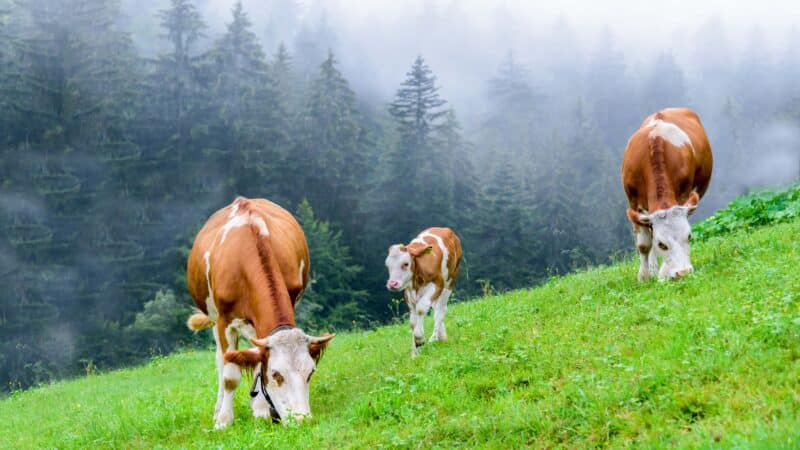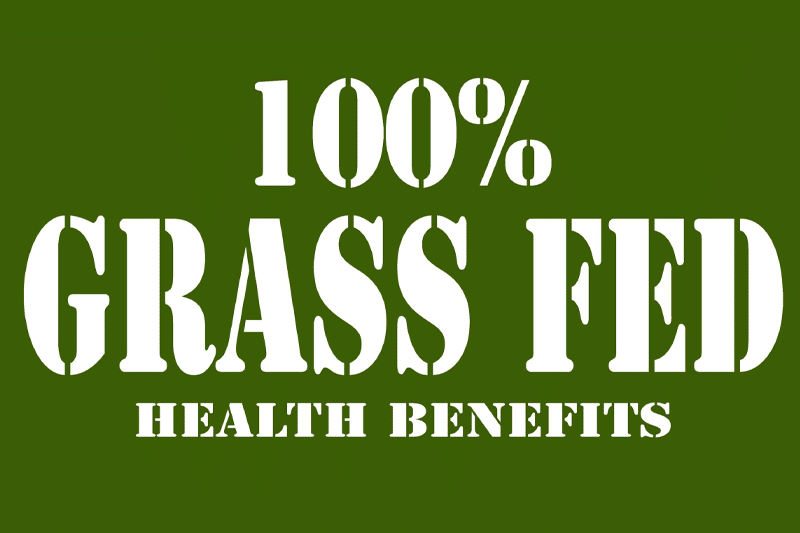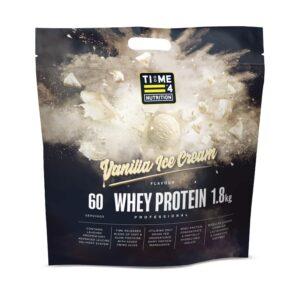Is Grass Fed Whey Protein Better Than Regular Whey Protein?
The Nutrient-Rich Advantage: Grass-Fed Cattle in Milk Production
Is Grass Fed Whey Protein Better Than Regular Whey Protein?
By Brian Batcheldor BSC
Over the last couple of years, we’ve been continuously informed about the growing concern over the environmental cost of the food we eat and the sustainability of its production. Few industries have been cited more in this campaign than dairy farming, with the real hotbed of debate being the health and ethical considerations of its feed practices, most notably, grass-fed vs conventional (grain) feedlot operation. However, during this same period, there has also been a growing awareness and appreciation for the quality of food we consume, with an increasing number of consumers recognizing the advantages of grass-fed alternatives. Pulling away from the crowd in this emotional melee, the Irish dairy industry has been keen to set out its stall when it comes to actually (scientifically) proving the advantages of its own dairy practices, specifically that Irish grass-fed milk contains more beneficial nutrients than milk from conventional indoor-feeding practices. Researchers from Teagasc* and Food for Health Ireland (FHI) discovered that dairy cows who operate on an Irish grass-fed system produced milk with higher percentages of omega-3 and conjugated linoleic (CLA) fatty acids compared to cows fed medium and low proportions of grass, further highlighting the nutrient-rich advantages that make such a system the superior choice for those seeking not only high-quality dairy but also a healthier lifestyle.

Whilst it’s important to point out that grass-fed and undenatured materials/practices do not necessarily come hand in hand, the undenatured material utilised in the new Time 4 range is sourced from skimmed milk production, the cooperatives producing this high-quality material use only grass-fed animals, providing customers with the best of both worlds, -undenatured material and a superior nutrient profile. Having created the initial awareness of the “fast” and “slow” protein concept and protein denaturation in the domestic market back in the late nineties, I have predictably since witnessed many companies jump on the bandwagon by falsely slapping these descriptions on their product labels anyway, -unfortunately, Trading Standards pretty much only care about the accuracy of the sugar content in these products when it comes to misleading claims.
Before we dive straight into the main findings of this recent publication, I think a quick reminder of the environmental and ethical advantages of pasture (grass) feeding is in order.

Is Grass Fed Whey Protein Better – Environmental considerations
1. Grass-fed cattle consume a diet primarily composed of pasture, -normally a mixture of grasses, legumes and herbs, with obvious implications for a broad range of nutrients/properties to be passed down into milk production, e.g. CLA, Omega 3’s, Beta-carotene, vitamin K2.
2. Reduces the reliance on resource-intensive grain production.
3. Supports sustainable and environmentally friendly agricultural practices which typically have a lower carbon footprint compared to conventional feedlot operations.
4. Promotes biodiversity and reduces the environmental impact of intensive farming practices.
5. Aligns with the growing consumer demand for eco-friendly and sustainable food options.
Is Grass Fed Whey Protein Better – Ethical Considerations
1. Grass-fed systems are often associated with higher standards of animal welfare, with cows having the opportunity to graze on pasture and exhibit natural behaviour.
2. Aligns with the values of consumers who prioritize ethical treatment of animals.
Is Grass Fed Whey Protein Better – A growing concern over antibiotic use
1. Grass-fed cattle are less likely to require antibiotics compared to their conventionally raised counterparts.
2. Supports efforts to reduce antibiotic resistance and promote a healthier food system.
3. Appeals to consumers seeking antibiotic-free dairy products.
Whilst I appreciate that many consumers may not care much for the above issues in the current economic climate, one way or another, these issues are going to affect the price you pay, if not in terms of a direct levy (e.g. plastic tax) then an increased cost of superior quality materials that are not produced locally.
So, lets now take a look at the nutritional advantages traditionally claimed for milk produced by pasture fed cows.

Nutrient Composition of Grass-Fed Milk
A. Omega-3 Fatty Acids:
1. Grass-fed milk is rich in omega-3 fatty acids, essential for heart health.
2. Higher levels of alpha-linolenic acid (ALA) contribute to anti-inflammatory properties.
3. Omega-3s are linked to improved cognitive function and reduced risk of chronic diseases.
B. Conjugated Linoleic Acid (CLA):
1. Grass-fed milk contains higher concentrations of CLA, known for its anti-cancer properties.
2. CLA supports weight management and promotes lean muscle mass.
3. Potential benefits in reducing the risk of cardiovascular diseases.
C. Antioxidants:
1. Grass-fed milk is a source of potent antioxidants like beta-carotene and vitamin E.
2. Antioxidants help combat oxidative stress, supporting overall health.
3. May contribute to skin health and immune system function.
C. Vitamin K2:
1. Grass-fed milk is a superior source of Vitamin K2 (menaquinone).
2. Vitamin K2 is essential for bone health as it directs calcium to bones and teeth.
3. Supports cardiovascular health by preventing arterial calcification.
D. Bioavailable Minerals:
1. Grass-fed milk provides more bioavailable forms of essential minerals like calcium and magnesium.
2. Enhanced mineral absorption contributes to better bone density and muscle function.
3. May reduce the risk of osteoporosis and other bone-related health issues.

E. Healthier Fats Profile:
Lower Saturated Fats:
1. Grass-fed milk generally has lower levels of saturated fats compared to conventionally produced milk.
2. Supports cardiovascular health by reducing LDL cholesterol levels.
3. Aids in maintaining a balanced and heart-healthy diet.
Balanced Omega-6 to Omega-3 Ratio:
1. Grass-fed milk maintains a more balanced ratio of omega-6 to omega-3 fatty acids.
2. A balanced ratio is associated with reduced inflammation and improved overall health.
3. Contributes to a healthier lipid profile.

What this latest research has confirmed
The new scientific paper, titled ‘Impact of varying levels of pasture allowance on the nutritional quality and functionality of milk throughout lactation’, has been published in the Journal of Dairy Science. Why was the study conducted in Ireland? Mark Timlin, a PhD researcher based in the Teagasc Food Research Centre in Co. Cork, explained:
“While grass-based feeding systems are the most common source of dairy produce here in Ireland, the levels of fresh grass fed to dairy cows in countries such as the United States, Germany, Austria and Denmark is significantly less than in Ireland”.
This study highlights the nutritional benefits of the Irish grass-fed system by comparing it to what is more commonly operated around the world, where cows are housed indoors year-round to maximize the quantities of milk produced. The research conducted compared the impact of three dairy systems on the nutritional composition and properties of milk. These systems compared:
A. A high grass allowance diet, typical of that operated by Irish farmers.
B. A medium grass allowance diet.
C. A low grass allowance diet most commonly operated around the world.
Researchers discovered that cows who grazed on an Irish high grass allowance diet produced milk with significantly more beneficial nutrients, compared to cows fed a medium, or low grass diet including:
• 83% increase in omega-3 fatty acids, including an improved n-3 to n-6 ratio;
• 141% increase in conjugated linoleic acids (CLA);
• Highest levels of unsaturated fatty acids (including mono- and polyunsaturated);
• Lowest levels of saturated fatty acids.

Dr André Brodkorb, Teagasc lead scientist commented: “This is the most comprehensive study of its kind, and we are rewarded with very clear information on the different milks produced. The high grass allowance diet investigated in this study is typical of the system implemented by the majority of dairy farmers in Ireland and meets the Bord Bia grass-fed standard for dairy produce”.
Food for Health Irelands’ Centre Director, Dr. Nessa Noronha commented: “These results mark part of a wider piece of research, which investigate the composition, functionality and sensory characteristics of Irish grass-fed dairy and the impact of the cow’s diet on human health. Irish grass-fed is a claim that is gaining more resonance with consumers as it is perceived as more natural and sustainable. The Food for Health Ireland team is committed to advancing the scientific credentials of Irish-grass fed dairy to help maintain and support Ireland as leaders in the production of sustainable, nutritious and tasty food – all of which are demanded by consumers.”
On a global scale, a premium may now be applied to Irish grass-fed dairy products, highlighting the nutritional benefits of ensuring a more natural and sustainable way of life for the farms in Ireland.
The advantages of grass-fed cattle in milk production extend beyond the pasture. From a nutrient-rich profile to environmental sustainability and ethical considerations, choosing grass-fed milk aligns with the growing demand for high-quality, conscientiously produced dairy products. As consumers become more discerning about their food choices, the shift towards grass-fed options reflects a commitment to personal health, environmental stewardship, and animal welfare. Embracing the nutrient benefits of grass-fed cattle in milk production is not just a culinary choice; it’s a holistic lifestyle decision with far-reaching positive implications.
Teagasc: The state agency providing research, advisory and education in agriculture, horticulture, food and rural development in Ireland.


